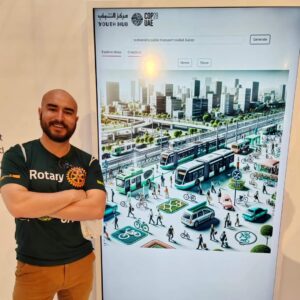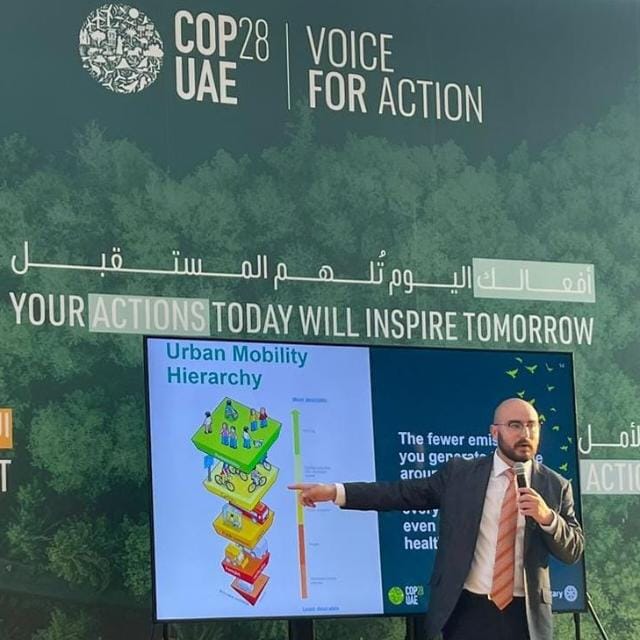by Ariel Miller
At the age of 28, Rotaractor Carlos Montoya heads the Integrated Transport Department of the North Zone of the State Government of Chihuahua, which serves principally for Ciudad Juárez, the most populous city in the northern Mexican state of Chihuahua. He’s working passionately to shape a city fair to all concerned, and he’s well-equipped, thanks to years of work building expertise in sustainable urban planning and earning the trust of community stakeholders.
“In the Chamber of Commerce and other networks, I take every opportunity to speak and they listen,” says this youthful ESRAG Director, one of only four Accredited Professionals Eco-District Certified in Mexico, and the only LEED Green Associate in his city. “I’m involved because this is where I live. In Ciudad Juárez they realize that they need more young people involved, and they know that young people are very worried about the future environmentally. The way things are going, I’d prefer to not have children. If things change for the good, I definitely want children.”
Feasible solutions exist, and cities are ideal for maximizing impact. “Cities generate around 60% of greenhouse gases but only occupy 2% of the land surface of the planet,” Carlos points out. “At the federal level, the political will to solve climate change is lacking, but we can do it at the city level.”
The solutions he is advocating go beyond mitigating climate change: they will also alleviate poverty and foster social cohesion.
Stop the urban sprawl: Ciudad Juárez is one of myriad cities worldwide suffering from 20th century decisions – “an example of how not to plan a city,” says Carlos. It forms part of a metro area including El Paso in Texas and Las Cruces in New Mexico, spanning roughly the same land area as Mexico City, but with only one fifth of the population. The harms are huge in terms of wasted money, greenhouse gas emissions, and air pollution.
“We have residents who spend up to 60% of their money on transportation: those who live in outlying areas and have to pay a lot to get to work, or spend up to four hours daily on buses,” Carlos points out. “Delivery of public services – sewage, transportation, and lighting – is eight times more costly than it would be in high-density cities.
Several neighborhoods are just too far away, with so few residents that bus operators can’t afford to serve them. The pandemic forced several public transport concessionaires go bankrupt because the need to prevent infections meant riders had to stop using the bus. This plus many other reasons made my city’s public transportation system collapse. We need 1,500 buses for public transport but we have fewer than 500.”
The combination of sprawl and inadequate urban mobility options “transformed car ownership from a luxury to a necessity in many parts of the world, amplifying our carbon footprint and needlessly inflating living costs for many,” says Carlos. “Transportation is the largest single source of greenhouse gases in my city.”
To reverse that, “We need building codes that encourage density,” he explains. “Urban codes need to have minimum heights for residential buildings.” Single-family housing drives up housing costs and forces sprawl as population grows, driving a lack of public and private investment in already existing areas. But longstanding cultural assumptions, reinforced by zoning and construction costs, pose an obstacle.
“The best incentive is to not allow any construction below minimum heights, by law. Minimum height is a climate change necessity: no room for negotiation,” says Carlos. “People say residents will not like to live in apartments because they are not used to it. But you won’t develop a culture if you don’t have the option. The first step is to build apartments. For those that already live in a house they can stay there, for those that want a house for their future, we have plenty for them already built here.”

Carlos with a map of sustainable public transport at COP 28.
As the city’s future, young people are the ideal market for multi-family developments. “The human being is a social species, and my generation is even more social,” says Carlos. “The lower the density, the greater the distances and the fewer people you are going to see in a day. The higher the density, the more options for school, urban mobility, work, shopping and recreation. And if you don’t want to see that many people, at least you can have a way better view from an apartment than a ground-level house. Juárez is quite flat, so from the third floor and above you can have a panoramic view at almost any point in the city.”
High-density communities make the greenest transportation options both practical and affordable. “I don’t like to spend money on a car: there’s gas, insurance, then a tire blows up and I have to buy a new one,” he continues. “There is the Urban Mobility Hierarchy to help you see what types of transportation are cheapest, most inclusive, and least harmful to the environment. You should plan the city according to this hierarchy. The best is walking, followed by bicycles. After that, it’s public transportation, then tractor-trailers (to move goods).
“The least infrastructure should go to the private car: it moves the fewest people, occupies the most space, and pollutes the most. Fifty cars can be replaced by just one bus.”
How can Rotarians change their cities’ mindsets? “One thing ESRAG and RI could do more on is educate ourselves on how the urban environment works,” Carlos adds. “You will motivate people by your knowledge and your integrity.” As he noted above, local Rotarians and Rotaractors have built-in credibility because they have a personal stake in the city’s future, by joining ESRAG they can boost their impact.
As a sustainability expert, Carlos puts a lot of time and energy into raising awareness, from recording short, energizing TikTok posts to serving as lecturer at Mexico’s most prestigious university system, the Instituto Politécnico Nacional. As ESRAG Co-Chair for Latin America, he has already helped to organize two Latin American environmental symposiums.
Until he went to COP 28 as one of Rotary’s international team in 2023, this was lonely work, because Mexico still has very few people working in sustainability. “No one from my state was at the COP. Most did not even know that a COP exists,” he says ruefully. “But I can work through Rotary to change that. Just after I got back, the local news station invited me to be part of a TV panel with the Chair of the Mexican Construction Industry Chamber of Juárez, the Director of the Municipal Institute of Research and Planning, and the city’s Urban Development Director.
“The fact that an ESRAG member was invited to that high-level conversation on TV shows that we are not tree-huggers, we are here to fix the planet,” Carlos says. “I am asking Juárez officials and leaders to send a city delegation to COP each year, so we can all work together to make the best city possible.”
He sees a number of ways that Rotarians can catalyze sustainable cities
- Convene the city’s stakeholders – business, government, academe – to explore strategies by enrolling them with experts on sustainable urbanization and urban mobility.
- Develop global grant projects on sustainable transportation: “a public bicycle service is feasible on a global grant budget,” he says.
- Sponsor young scholars preparing for careers in sustainability – another global grant option.
Carlos Montoya is an ESRAG Director, Co-Chair of ESRAG’s Latin American Chapter, and a member of the Rotaract e-Club for the Environment.
